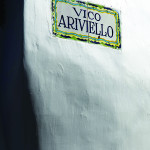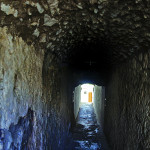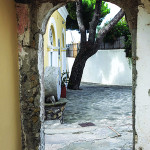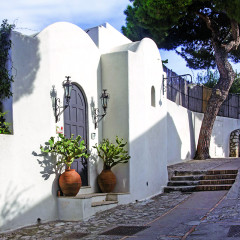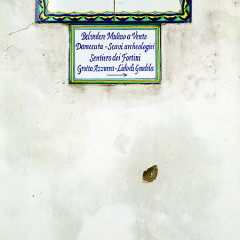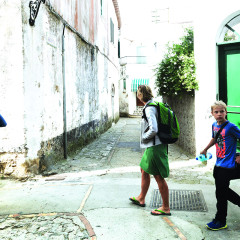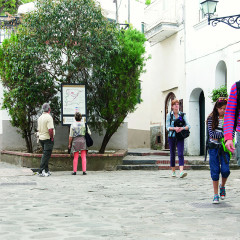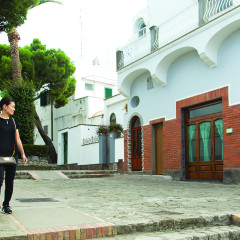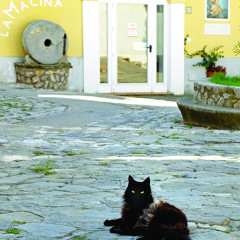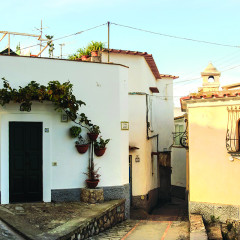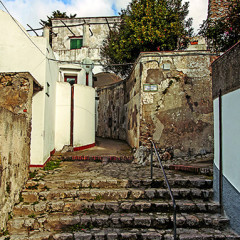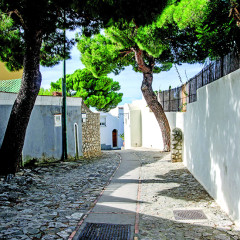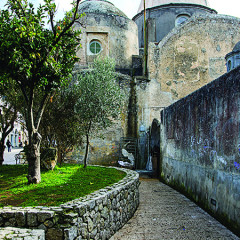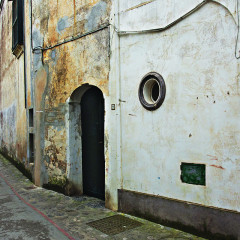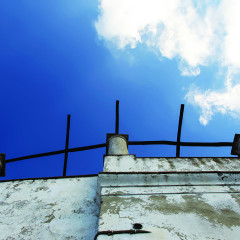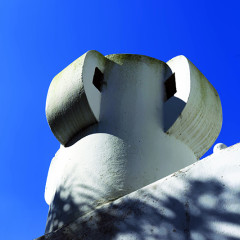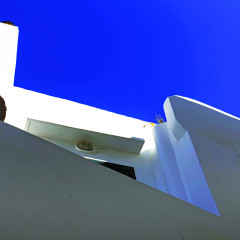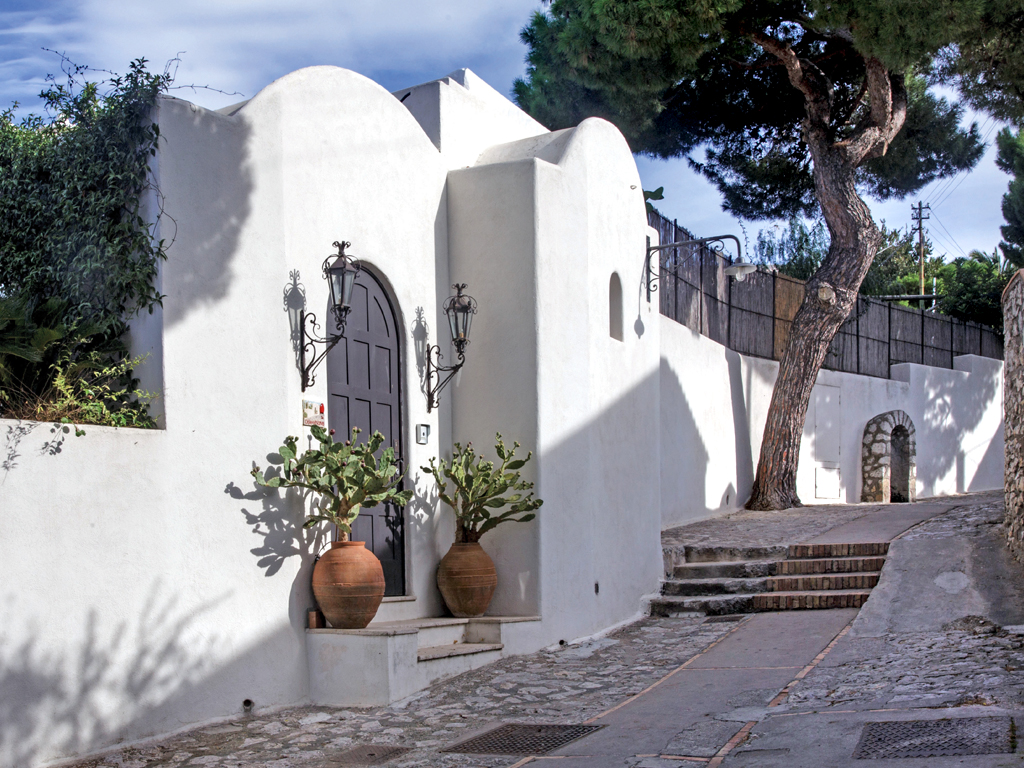
Un cuore antico
Quello di Anacapri si trova nella contrada Le Boffe. Un dedalo di vicoli da scoprire passo dopo passo
di Rossella Funghi | foto di Raffaele Lello Mastroianni
Panni stesi, vicoli che invitano ad entrare, rampe di scale con vasi fioriti. Qualche gatto al sole. In sottofondo l’eco di un televisore acceso, una musica, il vociare che filtra da una finestra aperta. Aromi di cucina che si stemperano nell’aria insieme al profumo di un gelsomino.
È l’atmosfera che si respira per il reticolo di strade che danno vita a Le Boffe, il cuore antico di Anacapri e il suo più antico quartiere cresciuto, a partire dal Seicento, intorno alla chiesa di Santa Sofia.
Per scoprirlo la cosa migliore è lasciarsi chiamare dai suoi vicoli percorrendoli tutti, lentamente, curiosando, fotografando, fermandosi a guardare le targhe di maiolica che danno il nome alle abitazioni. La casa del vescovo, Casetta ciammurra, ‘a casa ‘e Zelinda. Ma anche Casa Disney. E come suggeriva Edwin Cerio nella sua Guida inutile di Capri, «L’importante è di capire che le strade di Anacapri non hanno scopo né meta; non conducono dove uno vuole ma dove vogliono loro. Basta seguirle, averci fiducia, godere l’incanto dei paesaggi che discoprono».
La chiesa di Santa Sofia può essere il punto di partenza per quanti vogliano immergersi in questo dedalo di vicoli. È da qui, sulla sinistra, che inizia via Boffe e scende dolcemente fino alla piazza, il cuore del quartiere. Ad accogliervi due palme svettanti con intorno una seduta in pietra e due grandi pini marittimi a fare da quinta. Intorno viuzze che invitano ad essere percorse.
Di tanto in tanto fuori da un portone il tralcio di una vite si inerpica in alto, verso il rincorrersi delle nuvole e raggiunge un pergolato che rimanda tutta la nostalgia di tempi passati quando ogni abitazione aveva la sua pergola e l’uva era un dono dell’autunno. O il tronco un po’ contorto di una bouganville va a creare un ricamo fiorito con l’azzurro del cielo a fargli da sfondo.
I muri delle case si alternano in un dolce susseguirsi di intonaci. Quelli bianchi, candidi, freschi di pittura lasciano il passo a quelli dove il tempo ha depositato pennellate di colori sfumati e a qualche muro “a dispietto”. Sì perché per “dispetto”, solo per dispetto, qui si innalzavano piccoli muri di nessuna utilità ma con il solo scopo di togliere la vista a qualche vicino poco simpatico. Veri e propri monumenti al “risentimento vendicativo” come lo definiva Claretta Cerio.
Tante le rappresentazioni su tela che ci restituiscono gli scorci di questo piccolo e affascinante labirinto. Nel museo Casa Rossa si può ammirare quella dell’inglese Robert Payton Reid dove Le Boffe sono la panoramica quinta che si stende dietro a una terrazza d’Anacapri. Ma la veduta più raffigurata nelle opere degli artisti si trova tra via Cera e la III traversa Boffe, è una casa bianca con le volte “a boffa”, le caratteristiche volte a padiglione simili a quelle piccole enfiature che si for- mano sotto la crosta del pane e che in dialetto locale son dette “boffe”. Ma l’origine del toponimo non è certa, forse deriva da “abboffare”, forse da una deformazione popolare del nome del principe di Elboeuf comandante della guarnigione francese di stanza ad Anacapri all’inizio dell’Ottocento. Anche se l’antico abitato porta forti i segni dei tempi moderni, è in questa zona che sono presenti ancor oggi il maggior numero di antiche costruzioni caratterizzate da architetture povere ma pittoresche. Tra tutte la volta. A botte, a schiena d’asino, a vela. Lo sguardo più attento può scoprire buffi comignoli dalle forme fantasiose, finestrelle abbellite da bifore, spigoli smussati che addolciscono un passaggio. E capita di incontrare muri con curiosi rigonfiamenti che altro non sono che le “pance” delle cisterne che si protendono verso la strada per sfruttarne lo spazio.
Sui muri anche numerose mattonelle in ceramica che nelle fogge più varie restituiscono l’immagine di Sant’Antonio, patrono di Anacapri. Amato e pregato. La devozione ha il suo punto culminante nella processione del 13 giugno tra gli spari dei fuochi beneauguranti e il suono delle campane in festa. Uno spettacolo tra fede e folclore che vede piazzetta Boffe e l’intero quartiere addobbati per l’occasione con grandi arazzi di fiori.
Poi tutto torna tranquillo. E si può ricominciare a perdersi per questi dolci vicoli.
Vico Ariviello
Un metro e quaranta per ventidue. Un budello che attraversa l’omonimo palazzo che porta il nome di una delle famiglie più antiche di Anacapri. Non perdetelo, imboccatelo da piazza Boffe e vi troverete tutta l’arte dei mastri muratori che lo hanno realizzato lavorando la pietra calcarea frammista a malta di lapillo.
Un lume, un portone, qualche grata e lo splendido sottoportico che purtroppo mostra i segni di recenti ferite. In fondo, uno spicchio di cielo ornato da una palma e una rampa di scale che si tuffa nella zona de La Vigna. | Vico Ariviello. Don’t miss this passageway, 22 metres long and 1.40 metres wide, named after one of the most ancient families in Anacapri, that runs through the building with the same name. If you enter it from Piazza Boffe, you’ll see all the skills of the master builders who created it, working the limestone mixed with lapilli mortar.
A lamp, a doorway, some gratings and the splendid porch, unfortunately bearing signs of recent damage. At the end is a glimpse of sky ornamented with a palm tree and a flight of stairs that takes you down into the La Vigna quarter.
An ancient heart
The old heart of Anacapri is in the Le Boffe quarter. A maze of narrow streets to explore step by step
by Rossella Funghi | photos by Raffaele Lello Mastroianni
Clothes hanging on the washing line, alleys enticing you to enter, stairways with pots full of flowers. Cats lying in the sun. In the background, the sound of a television, music, gossip coming from an open window. Cooking smells dissolving into the air, mingled with the scent of jasmine.
They are all part of the atmosphere pervading the network of streets that make up Le Boffe, the old heart of Anacapri and its most ancient quarter which grew up around the church of Santa Sofia from the 17th century onwards.
The best way to explore it is to allow yourself to follow the call of its streets, strolling along them slowly, peeking in here and there, taking photos and stopping to look at the majolica tile signs with the names of the houses: La casa del vescovo, Casetta ciammurra, ‘a casa ‘e Zelinda. Even Casa Disney. And as Edwin Cerio suggested in his Guida inutile di Capri (Unnecessary guide to Capri), “The important thing is to understand that the streets of Anacapri have no reason or purpose; they don’t lead where you want to go but where they want to go. You just follow them, just trust them and enjoy the enchanting vistas they reveal.”
The church of Santa Sofia is a good starting point for anyone wanting to plunge into this maze of streets. This is where Via Boffe starts on the left, sloping gently down towards the piazza, the heart of the quarter. Two soaring palm trees greet you, surrounded by a stone seat with two large maritime pines in the background. All around are little lanes, beckoning you in.
From time to time, a vine shoot climbs up outside a doorway towards the scudding clouds, reaching up into a pergola and inspiring a nostalgia for the past, when every house had its own pergola and autumn brought the gift of grapes each year. Or the slightly twisted trunk of a bougainvillea creates a flowery embroidery, with the blue of the sky providing the background.
The plastered walls of the houses alternate with each other in gentle sequence: freshly painted gleaming white ones are followed by walls painted in mellow shades by the brush of time, and the “spiteful” walls. Yes, spiteful, because these small walls were built out of pure spite with no other purpose than to deprive a hated neighbour of their view. They stand as genuine monuments to “a vindictive grudge”, as Claretta Cerio put it.
But there are many paintings that restore the lost views to this fascinating little labyrinth. In the Casa Rossa museum you can admire the painting by Scottish artist Robert Payton Reid, where the Le Boffe quarter provides the panoramic backdrop behind an Anacapri terrace. But the view most frequently painted by artists, between Via Cera and Traversa III Le Boffe, is a white house with the “a boffa” roof: the distinctive hip roof similar to the little puffs that form under the crust of a loaf of bread, known in local dialect as “boffe”. But the origins of the name of the quarter are uncertain: it could derive from “abboffare” (to gorge yourself), or it might be a corruption of the name Prince of Elboeuf, the commander of the French garrison stationed in Anacapri at the beginning of the 19th century.
Although the old town centre shows obvious signs of modernity, this area still has the largest number of historic buildings with a simple yet picturesque rustic style of architecture, particularly the roofs, with their barrel or ribbed vaulting or saddle roofs. If you look carefully, you’ll be able to pick out the comical chimney pots in bizarre shapes, the mullioned windows, or the rounded edges softening a passageway. And you may come across strange bulges in the walls that are actually the “bellies” of water cisterns, projecting out into the road to make the most of the space.
The walls also contain many ceramic tiles with a wide range of depictions of the image of Sant’Antonio (Saint Anthony), the much loved patron saint of Anacapri, to whom many prayers are dedicated. The devotions reach a peak with the procession on 13 June, amid the firing of guns into the air for good luck and the pealing of holiday bells. It is a spectacle somewhere between religious belief and folklore, and the Piazzetta Boffe and the whole quarter are decked with great tapestries of flowers for the occasion. Then peace and quiet return. And you can begin to lose yourself again amongst the lovely alleys.


